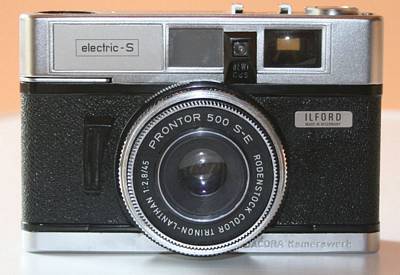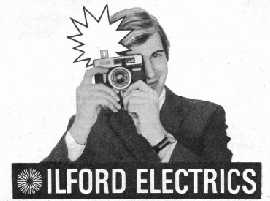|
In Amateur Photographer magazine
for 12th April 1967, Ilford took out a two full page advert to
announce their New Ilford Electrics range, which suggests the
Electrics range was introduced around that time. Its probable
that the range first appeared at the beginning of 1967, as the
accompanying instruction booklet bears the Ilford coding for
January 1967 (A67; my thanks again to Andy Holliman for this
information). This is a reasonable timescale, as the 'Electrics'
incorporate the first use of CdS light metering within the Ilford
camera range, a feature which was becoming commonplace on 35mm
cameras by that time. The automatic versions within the Sportsman
300 range, believed to have been released in 1965, were based
upon the 'older technology' of selenium cells.
Note the obvious DACORA
Kamerawerk name indented into the brightwork of the base
plate, to the lower RHS of the above illustration. Clearly Ilford
were not trying to disguise the source of the Electric range.
There were four cameras
within the range, but
possibly only three were sold in the UK. The electric-CR, -L
and -SR were (I believe) the only ones advertised in UK magazines.
However, Allard Wunderink of The Netherlands has sent me pictures
of the fourth model, the electric-S.
The name 'electric' appears
without the capitalised 'E' on the camera fronts, but in the
Ilford adverts the name was capitalised. Also, the hyphen, which
connects with the model type i.e. '-SR' on the camera front,
was omitted by Ilford in their adverts, hence, Electric SR.
|


|
The electric-CR, priced
at £26.10s = £26.50p, having a coupled rangefinder
but no automatic exposure setting; readings from the built-in
CdS exposure meter had to be manually transferred to the shutter
and aperture. The lens is a 45mm Color-Isconar f2.8 and the shutter
a Prontor 300, giving 1/30, 1/60, 1/125, 1/300 & B. Fitted
with a bright-line viewfinder. In a Dollonds sale in AP magazine,
January 1970, the price, new, was £22.50p. Note the flash
cube socket, top LHS.
The electric-L, priced at £30.2s.6d = £30.12½p,
without the rangefinder but having semi-automatic exposure control
via a match-needle arrangement visible in the viewfinder. Thus,
shutter speeds and apertures were semi-automatically coupled
to the built-in CdS light meter. The lens is a 45mm Rodenstock
f2.8 Color Trinon-Lanthan in a Prontor 300-E shutter, offering
the same speeds as the Electric CR. With a bright line viewfinder.
In a Dollonds sale in AP magazine, January 1970, the price, new,
was £26.50p.
|
 |
Top of the range is the electric-SR,
illustrated head of the page, priced £37.2s.6d = £37.12½p,
having both the rangefinder and a 'fully cross-coupled exposure
control'. The lens is the same as fiited to the 'L' version but
the shutter is the Prontor 500 S-E, giving 1/30, 1/60, 1/125,
1/250, 1/500 and B. It has a delayed action release and bright
line viewfinder. In a Dollonds sale in AP magazine, January 1970,
the price, new, was £33.50p.
Alongside and below is shown
the electric-S, illustrated in pictures sent by Allard
Wunderink. Allard says his electric-S looks like an electric-SR,
except it does not have a coupled rangefinder. It has the same
(Alfred Gauthier Calmbach) Prontor 500 S-E shutter and 45mm Rodenstock
Color Trinon-Lanthan f2.8 lens as the electric-SR (see picture
at the top of this page).
|
 |
The contemporary Ilford advert
requested readers to:
"Look at the new Ilford
Electric SR. The light meter - built-in, is controlled by a CdS
(cadmium sulphide) photo-resistor for hypersensitivity, powered
by a minute electric cell giving an incredible life-span of dependable
power. An on-off switch prevents battery wastage. The same cell
electrically couples speed and aperture settings to the meter
reading. Two gold-plated manganese alkaline batteries keep ample
power on tap in the cameras and connect with the built-in flashcube
socket. The miniaturized 'electrics' throughout the new Ilford
Electric range are as dependable as the most tried and tested
mechanical operations in 35mm photography."
|